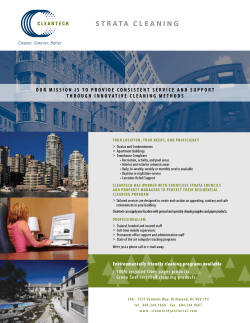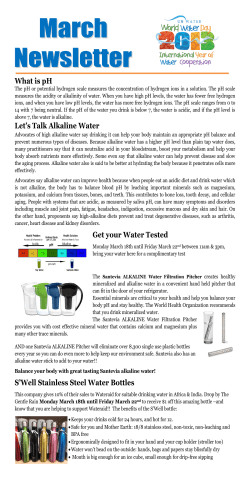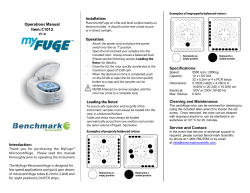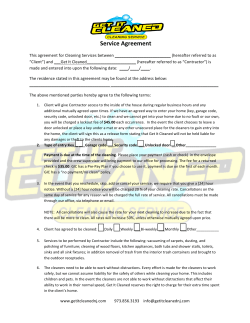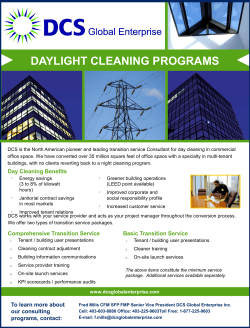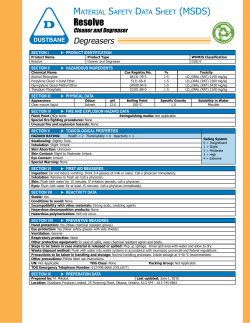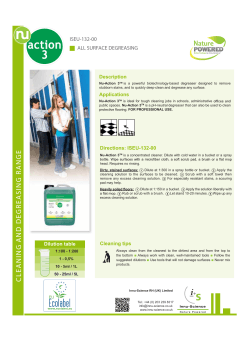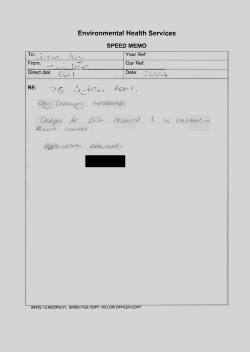
A Cleaning System Primer: The Essentials of Cleaning
A Cleaning System Primer: The Essentials of Cleaning Blair Vandivier President Asterion, LLC March 28, 2015 Why Clean? • All parts are soiled during the manufacturing process • These soils interfere with subsequent finishing operaFons • Soils are from a variety of sources • Drawing Compounds • Buffing Compounds • Lubricants • Rust PreventaFves • Airborne soils from storage Why Clean? What is cleaning? • Cleaning is the removal of unwanted contaminants to allow the substrate to be finished in subsequent operaFons • A clean surface must also be acFve and free from all substances that will interfere with the bond, adhesion or uniformity of the finished deposit • The cleaning process must not damage the substrate while removing soils Cleaners • Cleaners operate by removing both organic and inorganic contaminants on the surface of the part • Examples of organic materials are mineral, animal and vegetable oils, waxes, lubricaFng addiFves, metallic soaps from buffing operaFons and inhibitors • Inorganic materials include oxides, scale, smut, polishing compounds, metallic residues and phosphate or conversion coaFngs Cleaning Methods • Solvent Wiping • Vapor Degreasing • Emulsion Cleaning (Organic Solvent in Water) • Alkaline Cleaning • Acid Cleaning • Mechanical Cleaning Solvent Wiping Vapor Degreasing Immersion Cleaning Mechanical Cleaning Aqueous Alkaline Cleaners • Aqueous based alkaline cleaners are the most common materials used in commercial metal finishing to remove organic contaminants • The earliest alkaline cleaners were made from animal fats and causFc potash (lye) • Today’s alkaline cleaners are complex blends of alkalinity, surfactants, sequestering agents and condiFoners to effecFvely remove organic soils Aqueous Alkaline Cleaners • Alkaline cleaners are the mainstay for the removal of organic soils from ferrous (steel) substrates • Acid cleaners are appropriate for cleaning non ferrous soV metals • Alkaline cleaners may etch non ferrous metals which may not be desirable • Some aluminum cleaners do use etching alkaline cleaners to accomplish both cleaning and etching in a single step Alkaline Cleaners Work By • Solvent Ac+on: This property enables the cleaner to dissolve the oils present on the metal surface Alkaline Cleaners Work By • Saponifica+on: In this alkaline process, oils and faWy acids are chemically converted into a soap and made water soluble Alkaline Cleaners Work By • Detergency: Surfactants (weXng agents) reduce the interfacial tension between the substrate and surface contaminants, enabling cleaning soluFons to penetrate and displace the oils from the surface being cleaned Alkaline Cleaners Work By • Emulsifica+on: The suspension of parFcles and oils in the aqueous cleaner phase through the use of surfactants Aqueous Alkaline Cleaners Work By • Removing soils from the surface by both chemical and physical acFon • Chemical cleaning occurs by the chemical reacFon which causes the removal of the soils through the saponificaFon of the soil on the surface • Physical cleaning occurs from the use of heat, agitaFon or some form of current on the surface Composition of Alkaline Cleaners • Alkaline cleaners typically consist of building elements which provide a source of alkalinity such as sodium or potassium hydroxides • AddiFonal alkaline builders such as phosphates, pyrophosphates, polyphosphates, silicates and carbonates are oVen used • These materials soVen the water to form soluble complexes with metallic ions in water Composition of Alkaline Cleaners • The funcFon of the phosphate and silicate materials is to keep small dirt parFcles dispersed in the cleaner to avoid redeposiFon of the dirt onto the substrate • These materials are also called sequestering agents, which react with calcium, magnesium and other metals in hard water to avoid precipitaFon • As the materials are held or sequestered they can no longer react with other materials to form undesirable species • Silicates parFcularly inhibit alkaline aWack on soV metals Composition of Alkaline Cleaners • Water condiFoners are employed to sequester metallic ions of Calcium, Magnesium and Iron • These chelaFng agents hold metallic ions in soluFon to prevent them from redeposiFng upon the substrate • ChelaFng agents such as EDTA are too effecFve and hold the metallic ions too Fghtly causing waste treatment issues • These strong chelaFng agents are typically not found in modern cleaner formulaFons Sequestering Agents Composition of Alkaline Cleaners • Surfactants play a major role in the formulaFon of alkaline cleaners • Surfactants are also called Surface AcFve Agents because they disperse a number of soils and greases from the surface of the part • Surfactants are also called weXng agents or dispersants Composition of Alkaline Cleaners • Surfactants are very complex chemicals • Surfactants possess the ability of having both water repelling (hydrophobic) and water aWracFng (hydrophilic) qualiFes on opposite ends of the molecule • This allows these materials to penetrate the water-‐oil barrier of many organic soils Composition of Alkaline Cleaners • The hydrophilic part of the surfactant has a high affinity for water • The hydrophobic part of the surfactant has a high affinity for oil • The hydrophobic part can penetrate the oil and pull it out into the aqueous phase • These surfactants have allowed water based systems to replace vapor degreasing with organic solvents Composition of Alkaline Cleaners Composition of Alkaline Cleaners • Many different types of surfactants are used in aqueous based alkaline cleaners • Anionic Surfactants (NegaFve Charge) • Non-‐ionic Surfactants (No Charge) • Amphoteric Surfactants (Charge may vary based up on pH—low pH posiFve → high pH negaFve) Composition of Alkaline Cleaners • Anionic surfactants provide good detergency and are good coupling agents for other surfactants • Soap (combinaFon of causFc potash ash (lye) and animal fats) is an example of a naturally derived anionic surfactants • Anionic surfactants generally are high foaming Composition of Alkaline Cleaners • Non-‐ionic surfactants are syntheFc materials • Non-‐ionic surfactants are good emulsifiers • Non-‐ionic surfactants are many Fmes used as a de-‐dusFng agent in powdered cleaners • Non-‐ionic surfactants are oVen used as defoamers in spray cleaners Cloud Point in Cleaners • The solubility of a non-‐ionic surfactant in an alkaline soluFon will decrease with increasing concentraFon and temperature • This is known as the cloud point • When an alkaline cleaner is operated above its cloud point, the surfactant becomes water-‐insoluble and begins to act like an oil • The efficacy of the surfactant is lost and the surfactant actually inhibits the effecFveness of the cleaner Composition of Alkaline Cleaners • Amphoteric surfactants are similar to anionic surfactants • Amphoteric surfactants exhibit excellent stability in strong alkaline condiFons • Amphoteric surfactants can act as effecFve coupling agents for non-‐ ionic surfactants • When amphoteric surfactants are used, rinsing becomes excepFonally important • Improper rinsing will cause the formaFon of caFonic films which will impede subsequent finishing operaFons Considerations in Alkaline Cleaner Selection • Determine Metal to be cleaned: • Steel • Aluminum • Zinc • Copper and alloys • Stainless Steel • Must assure that the cleaner formulaFon selected does not aWack the substrate surface Considerations in Alkaline Cleaner Selection • The cleaner must be formulated to effecFvely remove soils • Drawing and stamping materials may require higher alkalinity • Waxes, heavy oil RP’s require higher heat and more aggressive alkalinity (Incorporate water soluble organic solvents) • Light rust protecFve oils and water soluble coolants are removed in moderate alkalinity at lower temperatures Considerations in Alkaline Cleaner Selection • Choose a cleaner suitable to the mechanics of the cleaning system • Emulsifying product • Displacing or oil floaFng to be removed by skimming or oil separator • Foam tolerance and control Types of Alkaline Soak Cleaners • Alkaline Cleaners are prevalent in two classes of soak cleaners • Emulsifying Cleaners which suspend the contaminants in the aqueous phase to allow the organic soil to become part of the cleaning soluFon • Non Emulsifying cleaners which allow the organic soils to float on top of the cleaning soluFon for removal by use of a weir or oil skimmer Types of Alkaline Soak Cleaners • Emulsifying Cleaners are specially formulated with surfactants which Fe up and contain the organic soils • The organic soils then become a part of the cleaning soluFon • The cleaning soluFon will funcFon unFl the soil load exceeds the ability of the surfactant package to contain the organic soils Emulsifying Cleaners Types of Alkaline Soak Cleaners • SeparaFng or oil displacement cleaners as the name implies allow the organic soils to be displaced from the surface of the part • These separated organic soils float on the surface of the alkaline cleaner • The separated soils then must be removed from the surface of the cleaner through an overflowing weir, oil separator or mechanical skimmer to avoid parts becoming contaminated when the parts are removed from the cleaning tank • The separaFng type cleaner will funcFon as long as effecFve separaFon occurs • It is difficult to separate syntheFc and water soluble oils with a separaFng type cleaner Types of Alkaline Soak Cleaners Non Emulsifying Cleaner with Weir Alkaline Soak Cleaners • Heat plays a criFcal role in the proper funcFoning of an alkaline soak cleaner • So long as the alkaline cleaner will tolerate heat, the hoWer the soluFon, the more effecFve the cleaning • The cloud point of the cleaner will determine the maximum temperature • OperaFon above the cloud point will diminish the effecFveness of the alkaline cleaner and may render it completely ineffecFve Alkaline Soak Cleaners • Heat provides the physical properFes of alkaline soak cleaning • Many organic soils are not readily removed in even the most effecFve cleaners at temperatures below 180⁰ F • Paraffinated organic materials (lubricants) and buffing compounds may require even hoWer temperatures which approach boiling in order to facilitate their removal Alkaline Soak Cleaners • In addiFon to temperature and chemistry, there are other factors to consider in order to properly clean • Time and mechanics are also important factors for consideraFon Alkaline Soak Cleaners • Time is a criFcal factor in the effecFveness of a cleaning system • The part must be provided sufficient Fme in the soak cleaner for the chemical and physical cleaning properFes to work • Many cleaning mechanisms such as emulsifying, dissolving, suspending and penetraFng soils are Fme dependent • Inadequate Fme will lead to inadequate cleaning • Excessive Fme can lead to damage of the substrate Alkaline Soak Cleaning • Mechanics also play a significant role in the cleaning process • AgitaFon can help in the cleaning process • AgitaFon provides a shear force which assists the chemical, heat and Fme of immersion to remove the organic soils • Increasing agitaFon may allow reduced Fme in the cleaner Alkaline Soak Cleaners • Water quality is also important to the cleaning system • Extremely hard water will impede cleaning by allowing metallic contaminants to reduce the effecFveness of the cleaner • If not sequestered, the metallic contaminants in extremely hard water may redeposit on the surface of the part during the cleaning process • Many alkaline soak cleaners contain water soVening agents to reduce the effect of hard water Alkaline Electrocleaners • Electrocleaning uses the applicaFon of a current on the part to liberate oxygen to effecFvely scrub the organic soils and oxide films from the surface of the part • Electrocleaning typically follows soak cleaning that removes the bulk of the heavy oils and other organic soils • The current flow is usually the opposite of that used in a plaFng cell (i.e. the work is anodic) • SomeFmes anodic electrocleaning is referred to as “reverse electrocleaning” Alkaline Electrocleaners • Under electrolysis, oxygen is liberated at the anode when current is applied • 4OH‾→O₂ + 2H₂O + 4e‾ • As the oxygen gas moves on the surface of the part, a scrubbing acFon occurs on the part which liVs the soil from the part • The oxygen bubbles coalesce and grow in size as they move over the surface which furthers the scrubbing acFon Alkaline Electrocleaning Alkaline Electrocleaners • Anodic electrocleaning can cause oxidaFon as well as a reducFon of pH at the surface of the part • This can result in oxidaFon of non ferrous metals • OxidaFon can be minimized by the use of silicates in the cleaner formulaFon • The oxidaFon phenomenon does not occur on steel, however alloys of steel containing nickel or high carbon may show similar effects (low alkalinity corrosion) Alkaline Electrocleaning • Cathodic Electrocleaning is also known as direct electrocleaning • The work is connected to the negaFve or cathodic terminal of the recFfier • When using a cathodic electrocleaning system, hydrogen gas is liberated at the surface of the part Alkaline Electrocleaning • Twice as much hydrogen is liberated in cathodic electrocleaning compared to the oxygen which is liberated in anodic electrocleaning • 2H₂O + 2e‾ → 2OH‾ + H₂ • More scrubbing acFon is provided by cathodic electrocleaning than anodic electrocleaning • Direct electrocleaning is typically not used on high strength steels because of the potenFal of hydrogen embridlement • There is also the potenFal for the deposiFon of metallic smuts on the parts • The liberaFon of hydrogen gas is noted by the presence of “popping” sound when the hydrogen is ignited by a spark Alkaline Spray Cleaners • Alkaline spray cleaners use enhanced mechanical acFon to remove soils • The impingement acFon of the spray cleaner assists in the removal of heavy organic soils • The impingement supplements the chemical and heat to provide significant cleaning • Many Fmes, spray cleaning is employed prior to the immersion alkaline cleaning process Ultrasonic Cleaning • Ultrasonic cleaning involves the applicaFon of very high frequency sound waves above 20,000 Hz • CavitaFon by means of ultrasonics assists the cleaning soluFon by reaching blind holes, crevices and other hard to reach areas • Transducers are strategically located in the cleaning tank to reach the difficult areas Acid Cleaning • Many non ferrous parts do not react well with alkaline cleaners • Alkaline soluFons etch the non ferrous metals • Subsequent plaFng steps require a non etched part • Acid soluFons provide the answer for non ferrous metals Acid Cleaning • Acid cleaning systems are formulated similarly to alkaline cleaners • The acid acts as the base of the cleaner • Surfactants are uFlized to provide detergency and assist in the removal of organic soils • Electro cleaning is not uFlized with acid processes on non ferrous metals Acid Cleaning • Acids that are used as the chemical base may be inorganic acids • Strong mineral based acids • Sulfuric, Hydrochloric, Nitric acids are examples of strong mineral acids • Weak mineral acids such as boric acid • Mineral acids are very soluble in water Acid Cleaning • Organic acids which are weaker than inorganic acids are also used when acid descaling is the primary purpose of the acid cleaner • Organic acids are organic compounds with acidic properFes • Examples of Organic acids include formic acid, aceFc acid and carboxylic acids • Some alcohols can have acid properFes Cleaning Is A Complex Process • The myriad of soils present on the parts and the many variables associated with cleaner formulaFon negate the development of a “universal” cleaner • These many variables are illustrated by the doughnut chart showing the “Sinner’s Circle” Sinner's Circle Advanced Surface Technology, Moller & Nielsen 20% 20% Time Temperature Chemistry Mechanics 20% 20% 20% Water Removal of Oxide Films • Alkaline cleaning removes organic contaminants from the surface of the part • Alkaline cleaning will leave an alkaline film which must be removed • Oxide residues are not easily removed in alkaline soluFons • Alkaline films may be neutralized in an acid pickle • Oxide removal also occurs through pickling in acid Removal of Oxide Films • Any acid may be used, but Hydrochloric Acid is the most common in commercial metal finishing operaFons • Sulfuric Acid is relaFvely inexpensive and emits no noxious fumes like hydrochloric acid • Many Fmes acid salts are used including sodium bisulfate, fluoride, chloride and the salts of common acids • Proprietary acids or addiFves are used to extend the life of the acid or to inhibit the aggressiveness of the acid Removal of Oxide Films • Just as with cleaning, the addiFon of current may increase the effecFveness of pickling • Cathodic pickling is used on steel and weld scale • Anodic pickling is effecFve at smut removal from high carbon steels but will pit the substrate aVer some aging of the acidic soluFon Rinsing • When a part is transferred from one cleaning step to another, the part carries residues from the operaFng tank • Good rinsing between cleaning steps is as important as the cleaning itself to obtain a part that is suitable for finishing • AddiFonally, rinsing is important in the minimizing of waste treatment issues Rinsing • The primary purpose of rinsing is to minimize the introducFon of contaminaFon in the upcoming step from the previous step • In addiFon to the film from the previous step on the parts, the parts may contain soluFon that is dragged out into the upcoming soluFon • Avoiding this drag in and minimizing contaminaFon is the purpose of rinsing Rinsing • Many rinsing soluFons conFnue to use overflowing rinses • Overflow rinsing is a single tank with a conFnuous variable water supply and an overflow consisFng of a standpipe or side mounted overflow fiXng. • While this ensures that the rinse is kept clean, it does cause high water use and is not economical Rinsing • Counterflow or countercurrent rinsing is the most effecFve way to ensure parts are not carrying contaminaFon and that water use is conserved • In the counterflow rinse system, the first rinse is the most contaminant laden, the second rinse is less contaminated and the third rinse is the cleanest • Water flows against the flow of work in the process line When is a part clean? • The purpose of cleaning is to clean the part for a successful applicaFon of the finish • How is cleanliness determined? • Laboratory tesFng may involve weighing a part before and aVer cleaning, using ultra violet light to fluoresce the surface • The most common pracFcal definiFon is that the surface of the part produces a “water break free” finish When is a part clean? • A clean surface is hydrophilic-‐water will shed in a conFnuous unbroken sheet • If soil remains on the surface of the part, water will run off leaving un-‐weWed areas in which water is not present • An alkaline film will mask cleanliness • It is important the part is rinsed thoroughly aVer the last alkaline cleaning step, neutralized in dilute acid and rinsed before observaFon Water Break Free Surface Conclusions • Cleaning is a complex process with many variables • Technological advances afford increased opportuniFes to use aqueous systems in place of organic solvents • Electrocleaners provide enhanced cleaning of metal parts • Pickling is necessary to remove oxide films, smut and to neutralize any alkaline films remaining on the parts Conclusions • Rinsing is as important as the cleaning process itself • Waste treatment constraints and issues must be considered in selecFng the proper cleaning system • While a universal cleaner would be nice, it is a fantasy as there is no universal soil • The many variables (Sinner’s Circle) which must be considered in developing a cleaning cycle allow variability which may approach a universal cleaning system
© Copyright 2025

